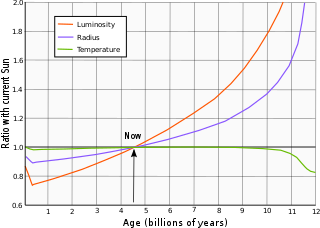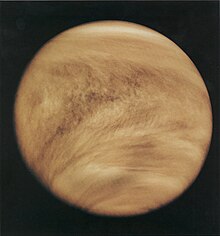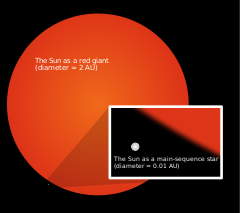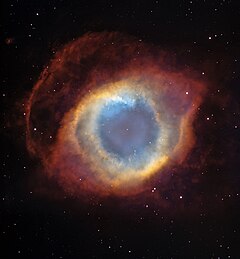地球の未来
出典: フリー百科事典『ウィキペディア(Wikipedia)』 (2023/08/25 02:06 UTC 版)
太陽の進化
太陽は、水素をヘリウムに転換する熱核融合反応をエネルギー源としている。この核反応プロセス(陽子-陽子連鎖反応)は太陽の中心核領域で起こっている。太陽核では対流は起こらず、核融合で生じたヘリウムは太陽全体に拡散することなく、中心核に蓄積される。太陽核の温度は、トリプルアルファ反応と呼ばれるヘリウム原子による核融合反応が起こるには低温すぎるため、これらのヘリウム原子は太陽の静水圧平衡を維持するのに必要なエネルギー総発生量に寄与しない[68]。
現在までに太陽の中心核にある水素のほぼ半分が消費されており、残った原子は主としてヘリウムで占められている。単位質量あたりの水素原子数が減少すると、水素の核融合反応で発生するエネルギー出力も減少する。これにより中心核の圧力が減少し、中心核の収縮が始まる。密度と温度の上昇により、中心核の圧力が、より上層の物質からの重力と平衡するまで収縮は続く。温度の上昇は残存する水素の核融合反応効率を増加させ、この平衡を維持するのに必要なエネルギーが発生する[68]。

この一連のプロセスは、太陽のエネルギー出力を絶え間なく増加させる。主系列星になった当初、太陽の光度は現在の70パーセントに過ぎなかった。太陽光度は1億1000万年につき1パーセントのペースで、ほぼ直線的に増加してきている[70]。同様に、30億年後の太陽光度は現在よりも33パーセント増加することが予想される。50億年後には中心核の水素が遂に使い果たされ、太陽光度は現在よりも67パーセント増加する。その後は中心核の周囲の殻で水素の核融合プロセスが継続される。このプロセスは太陽が現在よりも121パーセント光度を増すまで続き、その時点で太陽は主系列星としての一生を終える。太陽はその後、準巨星段階を経て赤色巨星に進化することになる[1]。
中心核の水素がなくなる時期には、天の川銀河とアンドロメダ銀河の衝突が始まっている可能性が高い。銀河同士の衝突は、太陽系を新しく形成される銀河からはじき出す可能性があるものの、太陽と太陽系の惑星に悪影響を与える可能性は低いと考えられている[71][72]。
気候への影響
気温の上昇は化学反応プロセスを加速し、ケイ酸塩鉱物の風化速度は上昇する。ケイ酸塩鉱物の風化プロセスは、二酸化炭素ガスを固体の炭酸塩に転換する。現在から6億年以内に、大気中の二酸化炭素濃度はC3型光合成を継続するためのしきい値(50ppm)を下回る。この時点で、現在の形態の樹木・森林は存続することができなくなる[73]。最後に生き残る樹木は常緑針葉樹となる[74]。一方でC4型光合成は、はるかに低い二酸化炭素濃度(10ppm超)でも継続することができる。C4型光合成を利用する植物(C4植物)は、最短でも現在から8億年後、長ければ12億年後まで生存する可能性がある。現在から12億年後には、上昇する気温により生物圏の維持は不可能になる[75][76][77]。目下、C4植物は地球上の植物バイオマスの約5パーセントに相当し、既知の植物種の1パーセントを占めている[78]。例として、イネ科の植物の約50パーセントがC4型光合成経路を利用しており[79]、同様にヒユ科の植物の多くがC4型光合成経路を利用する[80]。
二酸化炭素濃度がかろうじて光合成を継続できる限界の水準まで低下すると、大気中の二酸化炭素の比率は揺れ動き、上昇と下降を繰り返すと予想される。これにより、二酸化炭素濃度が(地殻活動と動物の影響によって)上昇するたびに陸上の植物は繁栄することができる。しかしながら、長期的な傾向においては残存する二酸化炭素も、その大半が大気中から失われることになり、最終的に陸上の植物はすべて死滅することになる[81]。一部の微生物はわずかな二酸化炭素濃度(数ppm)でも光合成を行うことが可能であり、このような生命体は気温の上昇や生物圏の喪失によってのみ絶滅を迎えると考えられる[75]。
植物(延長して考えるならば動物も)は、その生存戦略を進化させることで存続期間を延長できる可能性がある。例としては、光合成プロセスに要する二酸化炭素濃度を減少させる、食虫植物に進化する、乾燥に適応する、菌類の従属栄養植物に進化するなどが挙げられる。これらの適応現象は、地球が湿潤温室状態に入る直前の時期に出現する可能性が高い[74]。
植物の死は、最終的には酸素(およびオゾン)の減少をもたらす。酸素・オゾンは動物の呼吸、大気中で起こる化学反応、火山の噴火などによって失われ、それはDNAを損傷する紫外線への減衰作用を低下させる[74]だけでなく、動物の生存を不可能にする。動物の絶滅は、最初に大型哺乳類、次に小型哺乳類、鳥類、両生類、大型魚類、爬虫類と小型魚類、そして最後に無脊椎動物という順で発生することになる。絶滅が実際に起こる前に、動物は高地のような低温のレフュジア(refugia、退避地)に集中すると予想される。そのような場所では陸地の表面積が減少するため、個体群のサイズは制限される。小型の動物は大型のものに比べて必要な酸素量が少ないため、より長く生存すると考えられる。一方、長距離を移動することができる鳥類は、低温の場所を探す能力に長けており、哺乳類よりも生存に有利である[11]。
ピーター・D・ウォードとドナルド・ブラウンリーは、その著作『The Life and Death of Planet Earth』のなかで、地球上の植物のほとんどが死滅したとしても、一部の動物は生存し続ける可能性があると主張した。 ウォードとブラウンリーは、バージェス頁岩(カナダ、ブリティッシュコロンビア州)の化石資料を利用してカンブリア爆発時の気候を推定し、それを活用して太陽光度の増加と酸素濃度の減少による気温の上昇が、動物の最終的な絶滅をもたらすであろう未来の気候を予測した。ウォードらの予想では、一部の昆虫、トカゲ類、鳥類、小型哺乳類および海洋動物は、植物の大量絶滅後でも存続する可能性がある。しかしながら、植物による酸素の補充が得られない状況では、生き残った動物も数百万年以内に窒息により絶滅する可能性が高い。ある種の光合成が継続されることにより、十分な酸素が大気中に残されると仮定した場合でも、上昇し続ける地球の気温は徐々に生物多様性の減少をもたらすと考えられる[81]。
地球の気温が上昇し続けるなか、生き残った動物は極地(および地下)に追いやられる。それらの動物は主として極夜に活動し、酷暑の白夜は夏眠状態で過ごすことになる。地表のほとんどは不毛な砂漠になっており、ほとんどの生命は海洋に存在している[81]。しかしながら、陸上から海洋に流入する有機物の量が減ると、水中の酸素量も減少していく[74]。そして陸上の生命と同様の過程を経て、水中の生命も絶滅に追いやられる。この絶滅プロセスは、淡水種の消滅から始まり、無脊椎動物の消滅で締めくくられる[11]。もっとも長く生存する無脊椎動物は、生きた植物に依存しない生物(シロアリなど)や、熱水噴出孔に生息する生物(ガラパゴスハオリムシ属の環形動物など)であると考えられる[74]。これらの絶滅プロセスの結果、多細胞生物は約8億年後に絶滅を迎える可能性がある。同様に、13億年後には真核生物が絶滅する可能性があり、その後には原核生物だけが残される[82]。
海洋の消失

10億年後には、現在の海洋の約27パーセントがマントルに沈み込まれる[50]。一方、太陽光度が現在よりも10パーセント増加すると、地球表面の平均温度は320 K (47 °C; 116 °F)まで上昇する。その場合、地球の大気は「湿潤温室状態」に入り、海洋の蒸発が急激に進行する[83][84]。未来の地球環境を予想したモデルによると、湿潤温室状態では成層圏に含まれる水蒸気が増加していく。それらの水蒸気が太陽からの紫外線を受け、水分子が光解離によって分解されると、水素が地球の大気圏から流出する。このプロセスの最終的な結果として、現在から約11億年後には地球から海水が消滅する可能性がある[85][86]。
海洋が消滅した後も、深層地殻とマントルから絶えず水が放出されるため、地球表層には水が存在し続ける[50]。深層地殻とマントルには、現在の海洋に存在する量の数倍の水が存在することになると予想される[87]。水は極地にも一定量残ることが考えられ、時には暴風雨が発生する可能性もある。しかしながら、地球は基本的に乾燥した砂漠の惑星となり、赤道には大規模な砂丘地帯が広がっており、かつて海底だった場所に存在するいくつかの塩原は、チリのアタカマ塩原によく似た景観をもつことになる[12]。
プレートは潤滑剤としての海水を失い、その運動は停止する可能性が高い。もっとも顕著な地質学的活動のサインは、マントルのホットスポット上に位置する楯状火山がもたらすことになる[74]。こうした不毛な環境においても、地球上には微生物が生存している可能性があり、多細胞生物が存続している可能性も否定できない[84]。それらの微生物の大半は好塩菌であると考えられるが、金星における生命の仮説のなかで主張されるように、大気中で生存できるよう進化している可能性もある[74]。しかしながら、過酷さを増す環境により、現在から16億年後[82]から28億年後の間にはそれらの原核生物も絶滅に追いやられる可能性が高い。そのなかでも最後まで生存する原核生物は、高緯度・高高度の場所に残る池の中や、氷が取り残された洞窟内に生息するものだと考えられる。一方、地下の生命はより長く存続する可能性がある[11]。その後の変化の予測は、地殻活動のレベルに依存する。火山の噴火による絶え間ない二酸化炭素の放出は、地球の大気を金星の大気と同様の「超温室」状態に変える可能性があるが、既にプレートの運動が失われている可能性も高く、その場合ほとんどの炭酸塩は埋没したままで残される[12]。赤色巨星と化して光度を増した太陽が、埋没した岩石を加熱し、二酸化炭素を放出させるまでその状態は続く[87]。
未来における海洋の消滅は、地球の大気圧が低下していく場合、20億年にわたって先延ばしにされる可能性がある。より低い大気圧は温室効果の減少をもたらし、地表温度の上昇を抑える。この作用は、自然のプロセスによって窒素が大気から除去されることで発生する。有機堆積物の研究は、過去40億年間で最低でも100キロパスカル (0.99 atm)の窒素が大気中から取り除かれたことを明らかにしている。現在この100キロパスカル (0.99 atm)の窒素が大気中に解き放たれたと仮定すると、実質的に大気圧は2倍となる。このようなペースで起こる窒素の除去作用は、増加する太陽光度の影響を、今後の20億年間にわたって無効化することができる[88]。
現在から28億年後までには、地球の表面温度は極地においても422 K (149 °C; 300 °F)に達する。この時点で、環境の悪化により生命はどのような形であっても存在できなくなる。地球表層の水がこの時点ですべて失われると仮定した場合、以降太陽が赤色巨星になるまで地球の環境は変動しない[84]。約30億 - 40億年後には太陽光度が現在の値から35 - 40パーセント増加し、暴走温室効果が開始される[85]。暴走温室効果により、大気温度は上昇し地表温度は約1,600 K (1,330 °C; 2,420 °F)に達する。この高温状態は地球表面を融解させる[86][84]。一方で、太陽が赤色巨星段階に入るまでの間、地球はその大気のほとんどを維持する[89]。
現在から28億年後に生命が絶滅すると、生命の痕跡は最終的には消滅し、非生物的なプロセスが残す痕跡に置き換えられると予想される[74]。ただし、太陽が死滅した後も地球上に生命が存在すると考える科学者は少数ながら存在する[90]。
赤色巨星段階

太陽の中心核における水素の融合が終わり、中心核の殻の周囲の水素が融合され始めると、中心核は収縮を始め、一方で中心核より外側の層は膨張していく。その後の10億年間、太陽光度は絶え間なく増加していき、太陽が121億6700万歳になった時点での光度は、現在の光度の2730倍にも達する。この頃には地球の大気のほとんどが宇宙空間に散逸している。地球表面には溶岩の海が広がり、そのなかを金属・金属酸化物の大陸と耐火物の塊が漂っており、地表の温度は2,400 K (2,130 °C; 3,860 °F)を超える[91]。一方、赤色巨星になった太陽の質量は、太陽風によって急激に失われていく。太陽風は太陽の質量の約33パーセントを流出させると予想される。太陽質量の減少は重力的な影響を弱め、太陽系の惑星が描く公転軌道は大きくなる。地球の軌道半径は最大で、現在の値の150パーセントまで増加する[70]。
赤色巨星に向かう太陽の膨張は、その最終期においてもっとも激しくなる。太陽がおよそ120億歳になったとき、水星と金星は膨張する太陽に飲み込まれる可能性が高い。その時点での太陽の半径は最大1.2 AU (180,000,000 km)に達する。地球と太陽の外圏大気の間には潮汐作用が発生し、地球の公転軌道半径は減少する。太陽の彩層からの引力も軌道半径の減少に寄与する。これらの作用が太陽質量の変化による重力の減少を相殺するため、地球は太陽に飲み込まれていく可能性が高い[70]。
地球の軌道が減衰され、地球が太陽に接近していくと、アブレーションと蒸発作用により地殻とマントルは失われる。その場合、最大でも200年ほどで地球は最終的に破壊されることになる[92][93]。地球が消滅した後、その唯一の名残として、太陽の金属量の極わずかな増加(0.01パーセント)がもたらされる[94]§IIC。
別の可能性として、地球が太陽に吸収される事態を免れた場合でも、太陽の大気からの引力は月の軌道を減衰する可能性がある。月の軌道半径が18,470 km (11,480 mi)まで減少すると、月は地球のロッシュ限界を超える。ロッシュ限界を超えた月は、地球との潮汐作用によって破壊され、崩れた月は環 (天体)に変化する。地球を周回する環のほとんどが減衰され、破片が地球に衝突し始める。したがって、太陽に地球が飲み込まれない場合でも、この惑星は月を失う可能性がある[95]。
赤色巨星段階後

中心核のヘリウムが核融合によって炭素に転換された後、太陽の中心核は再び収縮を始め、外層のガスを惑星状星雲として流出させた後、小さな白色矮星へと進化する。現在から500億年後、地球と月が太陽に飲み込まれず残っていた場合、両者に潮汐ロックが起こり、地球と月は互いに常に同じ面で向かい合うことになる[96][97]。その後、太陽の潮汐作用が地球・月系の角運動量を奪い、月の軌道は減衰され、一方で地球の自転は加速される[98]。
地球・月系への太陽の干渉により、月は地球に向かって緩慢な速度で近づいていき、現在から約650億年後には地球と衝突すると予測されている[99]。
今後の30兆年という歳月の間には、太陽はほかの恒星との近接遭遇を経験することになる。結果として、太陽を公転する惑星の軌道は乱され、太陽系から放り出される可能性もある[100]。地球がここまでに挙げた全ての事象を回避すると仮定した場合、地球の最終的な消滅は、1020年(1垓年)後、重力放射による軌道の減衰の結果、黒色矮星と化した太陽と衝突することによってもたらされる[101]。
- ^ a b Sackmann, I.-Juliana; Boothroyd, Arnold I.; Kraemer, Kathleen E. (1993), “Our Sun. III. Present and Future”, The Astrophysical Journal 418: 457–68, Bibcode: 1993ApJ...418..457S, doi:10.1086/173407
- ^ Keith, David W. (November 2000), “Geoengineering the Environment: History and Prospect”, Annual Review of Energy and the Environment 25: 245–84, doi:10.1146/annurev.energy.25.1.245
- ^ a b c Vitousek, Peter M.; Mooney, Harold A.; Lubchenco, Jane; Melillo, Jerry M. (July 25, 1997), “Human Domination of Earth's Ecosystems”, Science 277 (5325): 494–99, doi:10.1126/science.277.5325.494
- ^ a b Haberl, Helmut et al. (July 2007), “Quantifying and mapping the human appropriation of net primary production in earth's terrestrial ecosystems”, Proceedings of the National Academy of Sciences of the United States of America 104 (31): 12942–47, Bibcode: 2007PNAS..10412942H, doi:10.1073/pnas.0704243104, PMC 1911196, PMID 17616580
- ^ a b Myers, N.; Knoll, A. H. (May 8, 2001), “The biotic crisis and the future of evolution”, Proceedings of the National Academy of Sciences of the United States of America 98 (1): 5389–92, Bibcode: 2001PNAS...98.5389M, doi:10.1073/pnas.091092498, PMC 33223, PMID 11344283
- ^ a b Myers 2000, pp. 63–70.
- ^ a b Reaka-Kudla, Wilson & Wilson 1997, pp. 132–33.
- ^ a b Bostrom, Nick (2002), “Existential Risks: Analyzing Human Extinction Scenarios and Related Hazards”, Journal of Evolution and Technology 9 (1) 2011年8月9日閲覧。
- ^ a b c d e Dutch, Steven Ian (2006), “The Earth Has a Future”, Geosphere 2 (3): 113–124, doi:10.1130/GES00012.1
- ^ a b c d Cochelin, Anne-Sophie B.; Mysak, Lawrence A.; Wang, Zhaomin (December 2006), “Simulation of long-term future climate changes with the green McGill paleoclimate model: the next glacial inception”, Climatic Change 79 (3–4): 381, doi:10.1007/s10584-006-9099-1
- ^ a b c d O'Malley-James, J. T.; Greaves, J. S.; Raven, J. A.; Cockell, C. S., “Swansong Biospheres: Refuges for life and novel microbial biospheres on terrestrial planets near the end of their habitable lifetimes”, International Journal of Astrobiology 12: 99–112, arXiv:1210.5721, Bibcode: 2013IJAsB..12...99O, doi:10.1017/S147355041200047X
- ^ a b c Lunine, J. I. (2009), “Titan as an analog of Earth’s past and future”, European Physical Journal Conferences 1: 267–74, Bibcode: 2009EPJWC...1..267L, doi:10.1140/epjconf/e2009-00926-7
- ^ Ward & Brownlee 2003, p. 142.
- ^ Fishbaugh et al. 2007, p. 114.
- ^ ニュートン2016年4月号 p. 134
- ^ Novacek, M. J.; Cleland, E. E. (May 2001), “The current biodiversity extinction event: scenarios for mitigation and recovery”, Proceedings of the National Academy of Sciences of the United States of America 98 (10): 5466–70, Bibcode: 2001PNAS...98.5466N, doi:10.1073/pnas.091093698, PMC 33235, PMID 11344295
- ^ Cowie 2007, p. 162.
- ^ Thomas, Chris D. et al. (January 2004), “Extinction risk from climate change”, Nature 427 (6970): 145–48, Bibcode: 2004Natur.427..145T, doi:10.1038/nature02121, PMID 14712274
- ^ Woodruff, David S. (May 8, 2001), “Declines of biomes and biotas and the future of evolution”, Proceedings of the National Academy of Sciences of the United States of America 98 (10): 5471–76, Bibcode: 2001PNAS...98.5471W, doi:10.1073/pnas.101093798, PMC 33236, PMID 11344296
- ^ Matthews, R. A. J. (March 1994). “The Close Approach of Stars in the Solar Neighborhood”. Quarterly Journal of the Royal Astronomical Society 35 (1): 1–9. Bibcode: 1994QJRAS..35....1M.
- ^ Scholl, H.; Cazenave, A.; Brahic, A. (August 1982). “The effect of star passages on cometary orbits in the Oort cloud”. Astronomy and Astrophysics 112 (1): 157–66. Bibcode: 1982A&A...112..157S.
- ^ Frogel, Jay A.; Gould, Andrew (June 1998), “No Death Star – For Now”, Astrophysical Journal Letters 499: L219, arXiv:astro-ph/9801052, Bibcode: 1998ApJ...499L.219F, doi:10.1086/311367
- ^ Tayler 1993, p. 92.
- ^ Rampino, Michael R.; Haggerty, Bruce M. (February 1996), “The "Shiva Hypothesis": Impacts, Mass Extinctions, and the Galaxy”, Earth, Moon, and Planets 72 (1–3): 441–60, Bibcode: 1996EM&P...72..441R, doi:10.1007/BF00117548
- ^ Tammann, G. A. et al. (June 1994), “The Galactic supernova rate”, The Astrophysical Journal Supplement Series 92 (2): 487–93, Bibcode: 1994ApJS...92..487T, doi:10.1086/192002
- ^ Fields, Brian D. (February 2004), “Live radioisotopes as signatures of nearby supernovae”, New Astronomy Reviews 48 (1–4): 119–23, Bibcode: 2004NewAR..48..119F, doi:10.1016/j.newar.2003.11.017
- ^ Hanslmeier 2009, pp. 174–76.
- ^ Beech, Martin (December 2011), “The past, present and future supernova threat to Earth's biosphere”, Astrophysics and Space Science 336 (2): 287–302, Bibcode: 2011Ap&SS.336..287B, doi:10.1007/s10509-011-0873-9
- ^ Laskar, J.; Gastineau, M. (June 11, 2009), “Existence of collisional trajectories of Mercury, Mars and Venus with the Earth”, Nature 459 (7248): 817–19, Bibcode: 2009Natur.459..817L, doi:10.1038/nature08096, PMID 19516336
- ^ a b Laskar, Jacques (June 2009), Mercury, Mars, Venus and the Earth: when worlds collide!, L'Observatoire de Paris, オリジナルの2011-07-26時点におけるアーカイブ。 2011年8月11日閲覧。
- ^ Adams 2008, pp. 33–44.
- ^ Shackleton, Nicholas J. (September 15, 2000), “The 100,000-Year Ice-Age Cycle Identified and Found to Lag Temperature, Carbon Dioxide, and Orbital Eccentricity”, Science 289 (5486): 1897–1902, Bibcode: 2000Sci...289.1897S, doi:10.1126/science.289.5486.1897, PMID 10988063
- ^ a b Hanslmeier 2009, p. 116.
- ^ a b Roberts 1998, p. 60.
- ^ Lunine & Lunine 1999, p. 244.
- ^ Berger, A.; Loutre, M. (1991), “Insolation values for the climate of the last 10 million years”, Quaternary Science Reviews 10 (4): 297–317, Bibcode: 1991QSRv...10..297B, doi:10.1016/0277-3791(91)90033-Q
- ^ Maslin, Mark A.; Ridgwell, Andy J. (2005), “Mid-Pleistocene revolution and the 'eccentricity myth'”, Geological Society, London, Special Publications 247 (1): 19–34, Bibcode: 2005GSLSP.247...19M, doi:10.1144/GSL.SP.2005.247.01.02
- ^ The eccentricity e is related to the semimajor axis a and the semiminor axis b as follows:
- Weisstein, Eric W. (2003), CRC concise encyclopedia of mathematics (2nd ed.), CRC Press, p. 848, ISBN 1-58488-347-2
- ^ Laskar, J. et al. (2004), “A long-term numerical solution for the insolation quantities of the Earth”, Astronomy & Astrophysics 428 (1): 261–85, Bibcode: 2004A&A...428..261L, doi:10.1051/0004-6361:20041335
- ^ Laskar, J.; Joutel, F.; Robutel, P. (February 18, 1993), “Stabilization of the Earth's obliquity by the Moon”, Nature 361 (6413): 615–17, Bibcode: 1993Natur.361..615L, doi:10.1038/361615a0
- ^ Atobe, Keiko; Ida, Shigeru; Ito, Takashi (April 2004), “Obliquity variations of terrestrial planets in habitable zones”, Icarus 168 (2): 223–36, Bibcode: 2004Icar..168..223A, doi:10.1016/j.icarus.2003.11.017
- ^ Neron de Surgy, O.; Laskar, J. (February 1997), “On the long term evolution of the spin of the Earth”, Astronomy and Astrophysics 318: 975–89, Bibcode: 1997A&A...318..975N
- ^ Donnadieu, Yannick et al. (2002), “Is high obliquity a plausible cause for Neoproterozoic glaciations?”, Geophysical Research Letters 29 (23): 42–, Bibcode: 2002GeoRL..29w..42D, doi:10.1029/2002GL015902
- ^ Lindsay, J. F.; Brasier, M. D. (2002), “Did global tectonics drive early biosphere evolution? Carbon isotope record from 2.6 to 1.9 Ga carbonates of Western Australian basins”, Precambrian Research 114 (1): 1–34, Bibcode: 2002PreR..114....1L, doi:10.1016/S0301-9268(01)00219-4
- ^ Lindsay, John F.; Brasier, Martin D. (2002), “A comment on tectonics and the future of terrestrial life – reply”, Precambrian Research 118 (3–4): 293–95, Bibcode: 2002PreR..118..293L, doi:10.1016/S0301-9268(02)00144-4 2009年8月28日閲覧。
- ^ a b c Ward 2006, pp. 231–32.
- ^ Murphy, J. Brendan; Nance, R. Damian; Cawood, Peter A. (June 2009), “Contrasting modes of supercontinent formation and the conundrum of Pangea”, Gondwana Research 15 (3–4): 408–20, doi:10.1016/j.gr.2008.09.005
- ^ a b Silver, Paul G.; Behn, Mark D. (January 4, 2008), “Intermittent Plate Tectonics?”, Science 319 (5859): 85–88, Bibcode: 2008Sci...319...85S, doi:10.1126/science.1148397, PMID 18174440
- ^ Trubitsyn, Valeriy; Kabana, Mikhail K.; Rothachera, Marcus (December 2008), “Mechanical and thermal effects of floating continents on the global mantle convection”, Physics of the Earth and Planetary Interiors 171 (1–4): 313–22, Bibcode: 2008PEPI..171..313T, doi:10.1016/j.pepi.2008.03.011
- ^ a b c Bounama, Christine; Franck, Siegfried; von Bloh, Werner (2001), “The fate of Earth’s ocean”, Hydrology and Earth System Sciences (Germany: Potsdam Institute for Climate Impact Research) 5 (4): 569–75, Bibcode: 2001HESS....5..569B, doi:10.5194/hess-5-569-2001 2009年7月3日閲覧。
- ^ Ward & Brownlee 2003, pp. 92–96.
- ^ Nield 2007, pp. 20–21.
- ^ Hoffman 1992, pp. 323–27.
- ^ Williams, Caroline; Nield, Ted (October 20, 2007), “Pangaea, the comeback”, New Scientist, オリジナルの2008-04-13時点におけるアーカイブ。 2009年8月28日閲覧。
- ^ a b Silver, P. G.; Behn, M. D. (December 2006), “Intermittent Plate Tectonics”, American Geophysical Union, Fall Meeting 2006, abstract #U13B-08, Bibcode: 2006AGUFM.U13B..08S
- ^ Nance, R. D.; Worsley, T. R.; Moody, J. B. (1988), “The supercontinent cycle”, Scientific American 259 (1): 72–79, Bibcode: 1988SciAm.259...72N, doi:10.1038/scientificamerican0788-72 2009年8月28日閲覧。
- ^ Calkin & Young 1996, pp. 9–75.
- ^ a b Thompson & Perry 1997, pp. 127–28.
- ^ Palmer 2003, p. 164.
- ^ Nimmo, F. et al. (February 2004), “The influence of potassium on core and geodynamo evolution”, Geophysical Journal International 156 (2): 363–76, Bibcode: 2003EAEJA.....1807N, doi:10.1111/j.1365-246X.2003.02157.x
- ^ Gonzalez & Richards 2004, p. 48.
- ^ Gubbins, David; Sreenivasan, Binod; Mound, Jon; Rost, Sebastian (May 19, 2011), “Melting of the Earth’s inner core”, Nature 473: 361–63, Bibcode: 2011Natur.473..361G, doi:10.1038/nature10068, PMID 21593868
- ^ Monnereau, Marc et al. (May 21, 2010), “Lopsided Growth of Earth's Inner Core”, Science 328 (5981): 1014–17, Bibcode: 2010Sci...328.1014M, doi:10.1126/science.1186212, PMID 20395477
- ^ Stacey, F. D.; Stacey, C. H. B. (January 1999), “Gravitational energy of core evolution: implications for thermal history and geodynamo power”, Physics of the Earth and Planetary Interiors 110 (1–2): 83–93, Bibcode: 1999PEPI..110...83S, doi:10.1016/S0031-9201(98)00141-1
- ^ Meadows 2007, p. 34.
- ^ Stevenson 2002, p. 605.
- ^ van Thienen, P. et al. (March 2007), “Water, Life, and Planetary Geodynamical Evolution”, Space Science Reviews 129 (1–3): 167–203, Bibcode: 2007SSRv..129..167V, doi:10.1007/s11214-007-9149-7 In particular, see page 24.
- ^ a b Gough, D. O. (November 1981), “Solar interior structure and luminosity variations”, Solar Physics 74 (1): 21–34, Bibcode: 1981SoPh...74...21G, doi:10.1007/BF00151270
- ^ Ribas, Ignasi (February 2010), “The Sun and stars as the primary energy input in planetary atmospheres”, Solar and Stellar Variability: Impact on Earth and Planets, Proceedings of the International Astronomical Union, IAU Symposium, 264, pp. 3–18, arXiv:0911.4872, Bibcode: 2010IAUS..264....3R, doi:10.1017/S1743921309992298
- ^ a b c Schröder, K.-P.; Connon Smith, Robert (2008), “Distant future of the Sun and Earth revisited”, Monthly Notices of the Royal Astronomical Society 386 (1): 155–63, arXiv:0801.4031, Bibcode: 2008MNRAS.386..155S, doi:10.1111/j.1365-2966.2008.13022.x
- ^ Cain, Fraser (2007), “When Our Galaxy Smashes Into Andromeda, What Happens to the Sun?”, Universe Today, オリジナルの17 May 2007時点におけるアーカイブ。 2007年5月16日閲覧。
- ^ Cox, T. J.; Loeb, Abraham (2007), “The Collision Between The Milky Way And Andromeda”, Monthly Notices of the Royal Astronomical Society 386: 461, arXiv:0705.1170, Bibcode: 2008MNRAS.tmp..333C, doi:10.1111/j.1365-2966.2008.13048.x
- ^ Heath, Martin J.; Doyle, Laurance R. (2009). "Circumstellar Habitable Zones to Ecodynamic Domains: A Preliminary Review and Suggested Future Directions". arXiv:0912.2482。
- ^ a b c d e f g h O'Malley-James, J. T.; Greaves, J. S.; Raven, J. A.; Cockell, C. S., “Swansong Biospheres II: The final signs of life on terrestrial planets near the end of their habitable lifetimes”, International Journal of Astrobiology 13: 229–243, arXiv:1310.4841, Bibcode: 2014IJAsB..13..229O, doi:10.1017/S1473550413000426
- ^ a b Caldeira, Ken; Kasting, James F. (December 1992), “The life span of the biosphere revisited”, Nature 360 (6406): 721–23, Bibcode: 1992Natur.360..721C, doi:10.1038/360721a0, PMID 11536510
- ^ Franck, S. et al. (2000), “Reduction of biosphere life span as a consequence of geodynamics”, Tellus B 52 (1): 94–107, Bibcode: 2000TellB..52...94F, doi:10.1034/j.1600-0889.2000.00898.x
- ^ Lenton, Timothy M.; von Bloh, Werner (May 2001), “Biotic feedback extends the life span of the biosphere”, Geophysical Research Letters 28 (9): 1715–18, Bibcode: 2001GeoRL..28.1715L, doi:10.1029/2000GL012198
- ^ Bond, W. J.; Woodward, F. I.; Midgley, G. F. (2005), “The global distribution of ecosystems in a world without fire”, New Phytologist 165 (2): 525–38, doi:10.1111/j.1469-8137.2004.01252.x, PMID 15720663
- ^ van der Maarel 2005, p. 363.
- ^ Kadereit, G. et al. (2003), “Phylogeny of Amaranthaceae and Chenopodiaceae and the Evolution of C4 Photosynthesis” (PDF), International Journal of Plant Sciences 164 (6): 959–86, doi:10.1086/378649, オリジナルの2011-08-18時点におけるアーカイブ。
- ^ a b c Ward & Brownlee 2003, pp. 117–28.
- ^ a b Franck, S.; Bounama, C.; von Bloh, W. (November 2005), “Causes and timing of future biosphere extinction”, Biogeosciences Discussions 2 (6): 1665–79, Bibcode: 2005BGD.....2.1665F, doi:10.5194/bgd-2-1665-2005 2011年10月19日閲覧。
- ^ Schröder, K.-P.; Connon Smith, Robert (May 1, 2008), “Distant future of the Sun and Earth revisited”, Monthly Notices of the Royal Astronomical Society 386 (1): 155–63, arXiv:0801.4031, Bibcode: 2008MNRAS.386..155S, doi:10.1111/j.1365-2966.2008.13022.x
- ^ a b c d Brownlee 2010, p. 95.
- ^ a b Kasting, J. F. (June 1988), “Runaway and moist greenhouse atmospheres and the evolution of earth and Venus”, Icarus 74 (3): 472–94, Bibcode: 1988Icar...74..472K, doi:10.1016/0019-1035(88)90116-9, PMID 11538226
- ^ a b Guinan, E. F.; Ribas, I. (2002), “Our Changing Sun: The Role of Solar Nuclear Evolution and Magnetic Activity on Earth's Atmosphere and Climate”, in Montesinos, Benjamin; Gimenez, Alvaro; Guinan, Edward F., ASP Conference Proceedings, The Evolving Sun and its Influence on Planetary Environments, Astronomical Society of the Pacific, pp. 85–106, Bibcode: 2002ASPC..269...85G
- ^ a b Brownlee 2010, p. 94.
- ^ Li, King-Fai; Pahlevan, Kaveh; Kirschvink, Joseph L.; Yung, Yuk L. (June 16, 2009), “Atmospheric pressure as a natural climate regulator for a terrestrial planet with a biosphere”, Proceedings of the National Academy of Sciences of the United States of America 106 (24): 9576–79, Bibcode: 2009PNAS..106.9576L, doi:10.1073/pnas.0809436106, PMC 2701016, PMID 19487662
- ^ Minard, Anne (May 29, 2009), “Sun Stealing Earth's Atmosphere”, National Geographic News 2009年8月30日閲覧。
- ^ “時間”はあと50億年で終わる?ナショナルジオグラフィック(archive.is)
- ^ Kargel, J. S. et al. (May 2003), “Volatile Cycles and Glaciation: Earth and Mars (Now and Near a Red Giant Sun), and Moons of Hot Jupiters”, American Astronomical Society, DPS meeting# 35, #18.08; Bulletin of the American Astronomical Society 35: 945, Bibcode: 2003DPS....35.1808K
- ^ Goldstein, J. (May 1987), The fate of the earth in the red giant envelope of the sun, 178, Astronomy and Astrophysics, pp. 283–85, Bibcode: 1987A&A...178..283G
- ^ Li, Jianke, et al. (August 1998), “Planets around White Dwarfs”, Astrophysical Journal Letters 503 (1): L151–L154, Bibcode: 1998ApJ...503L.151L, doi:10.1086/311546, p. L51
- ^ Adams, Fred C.; Laughlin, Gregory (April 1997), “A dying universe: the long-term fate and evolution of astrophysical objects”, Reviews of Modern Physics 69: 337–, arXiv:astro-ph/9701131, Bibcode: 1997RvMP...69..337A, doi:10.1103/RevModPhys.69.337
- ^ Powell, David (January 22, 2007), “Earth's Moon Destined to Disintegrate”, Space.com (Tech Media Network) 2010年6月1日閲覧。
- ^ Murray, C.D.; Dermott, S.F. (1999). Solar System Dynamics. Cambridge University Press. p. 184. ISBN 978-0-521-57295-8
- ^ Dickinson, Terence (1993). From the Big Bang to Planet X. Camden East, Ontario: Camden House. pp. 79–81. ISBN 978-0-921820-71-0
- ^ Canup, Robin M.; Righter, Kevin (2000). Origin of the Earth and Moon. The University of Arizona space science series. 30. University of Arizona Press. pp. 176–77. ISBN 978-0-8165-2073-2
- ^ Bruce Dorminey (2017年1月31日). “Earth and Moon May Be on Long-Term Collision Course”. Forbes. 2017年2月11日閲覧。
- ^ “Binary Stars can eject planets into interstellar space : Astronomy & Space Science”. Rational Skepticism Forum. 2017年12月15日閲覧。
- ^ Dyson, Freeman J. (1979). “Time Without End: Physics and Biology in an Open Universe”. Reviews of Modern Physics 51 (3): 447–60. Bibcode: 1979RvMP...51..447D. doi:10.1103/RevModPhys.51.447 2008年7月5日閲覧。.
- 地球の未来のページへのリンク
